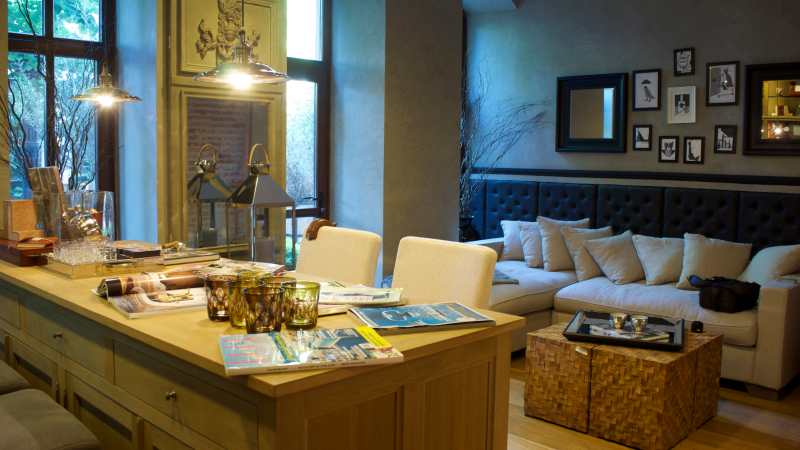Living in a small space doesn’t mean you have to feel cramped or cluttered. With a few smart design strategies, clever storage solutions, and the right mindset, even the tiniest apartment or home can feel spacious, open, and inviting. The key to understanding how to make a small space feel like a big place lies in thoughtful planning, visual balance, and functionality.
In this guide, we’ll explore creative ways to maximize your home’s potential — from choosing the right colors and furniture to using light, mirrors, and decor effectively.
1. The Psychology of Space: Why Design Matters
Before diving into design tips, it’s important to understand how perception affects how we experience space. The human eye interprets size not only by physical dimensions but also by visual cues such as light, color, and layout.
That means even a compact room can appear larger when you use certain design tricks. The goal is to create a sense of openness and flow that tricks the eye into feeling like there’s more space than there really is.
Good design helps small spaces feel not just bigger — but also calmer, more functional, and more comfortable.
2. Declutter and Simplify: The Foundation of Spacious Living
No matter how stylish your home is, clutter is the number one thing that makes it feel small. A clean, organized space automatically feels more open and breathable.
Start with these tips:
-
Declutter regularly: Go through each room and remove anything that doesn’t serve a purpose or bring joy.
-
Adopt minimalism: Keep only essential furniture and decor. Less is truly more when working with limited space.
-
Use hidden storage: Ottomans, under-bed drawers, and multi-purpose furniture keep items out of sight but easily accessible.
-
Create zones: Define spaces for work, rest, and entertainment to keep your home organized.
A clutter-free space gives the illusion of more square footage and helps you focus on comfort and design.
3. Choosing Colors Wisely: Light and Neutral for Openness
Color plays a powerful role in creating the illusion of space. Light shades reflect natural light and make walls seem farther apart, while dark colors can make rooms feel smaller.
Recommended color palette:
-
Whites, off-whites, and creams for walls.
-
Soft blues, light grays, or pastels for accents.
-
Natural tones like beige, sand, and taupe for warmth.
If you want contrast, keep darker shades for decor, furniture, or one accent wall to avoid overwhelming the space.
Pro Tip: Painting your ceiling a lighter shade than the walls can make it appear higher, adding to the feeling of openness.
4. Furniture Selection: Function Meets Flexibility
When working with limited space, each piece of furniture plays an important role in both function and design. Choose items that are functional, flexible, and sized proportionally to your room.
Smart furniture choices include:
-
Multi-purpose pieces: A sofa bed, nesting tables, or expandable dining tables save space.
-
Transparent materials: Glass tables or acrylic chairs reduce visual weight.
-
Raised furniture: Legs on sofas or cabinets create visible floor space and enhance openness.
-
Built-in storage: Shelving units and wall-mounted cabinets keep the floor area clear.
The trick is to select furniture that fits your lifestyle without overcrowding your space.
5. Let There Be Light: Maximizing Natural and Artificial Lighting
Light is one of the most effective ways to transform a small room. Bright, well-lit spaces naturally feel bigger and more welcoming.
a. Natural Light:
-
Keep windows uncovered or use sheer curtains to allow sunlight in.
-
Position mirrors to reflect natural light around the room.
-
Avoid blocking windows with bulky furniture.
b. Artificial Light:
-
Layer lighting with ceiling fixtures, floor lamps, and wall sconces.
-
Choose warm white bulbs for a cozy yet open feeling.
-
Add under-cabinet or shelf lighting to brighten dark corners.
Good lighting can completely change the mood of your home and is a key element in making a small space feel like a big place.
6. Mirrors: The Illusion of Depth and Space
Mirrors are a classic interior design trick that instantly doubles visual space. When placed strategically, they reflect light and scenery, making rooms appear more open.
Tips for using mirrors effectively:
-
Position a large mirror across from a window to maximize natural light and reflect it throughout the room.
-
Use mirrored furniture or decor for subtle reflection.
-
Group smaller mirrors in a pattern to create visual interest.
-
Install mirrored closet doors to create the illusion of more space and make your bedroom appear larger and brighter.
Mirrors add both elegance and function — the perfect balance for small homes.
7. Optimize Vertical Space
When you can’t expand outward, go upward. Vertical design draws the eye upward and makes ceilings feel higher.
Ideas for maximizing height:
-
Install tall bookshelves or storage units.
-
Hang curtains closer to the ceiling rather than directly above the window.
-
Use vertical artwork or long wall-mounted shelves.
-
Add plants on tall stands or hanging pots to lead the eye upward.
By using vertical elements, you’re visually extending your space — one of the most effective ways how to make a small space feel like a big place.
8. Flooring and Rugs: Creating Flow
Flooring plays a subtle but important role in spatial perception. Continuous flooring without abrupt transitions makes rooms feel larger and more cohesive.
Flooring tips:
-
Use the same flooring throughout connecting spaces for a unified look.
-
Choose lighter wood or neutral tones for a more expansive feel.
-
Avoid busy patterns that can visually shrink the room.
Rugs:
-
Choose larger area rugs that define zones without breaking the flow.
-
Match rug colors with walls or furniture to maintain harmony.
When the eye can travel smoothly across a room, it naturally feels bigger.
9. Decor and Accessories: Less but Impactful
Decor adds personality, but too much of it can make a small space feel cluttered. Focus on quality over quantity.
Effective decor tips:
-
Choose one statement piece per room (like a large painting or sculptural lamp).
-
Use light-colored, reflective materials for accessories.
-
Incorporate greenery — plants bring freshness and life without overwhelming the space.
-
Keep surfaces like tables and counters mostly clear.
Minimal yet meaningful decor maintains visual balance and sophistication.
10. Create Openness with Room Divisions
Instead of solid barriers, use visual or transparent dividers to define areas.
Ideas for small homes:
-
Use open shelving or screens to separate living and dining zones.
-
Glass partitions create definition without blocking light.
-
Rugs and lighting can also define functional zones.
This technique provides structure while preserving spaciousness — one of the core principles in how to make a small space feel like a big place.
11. Smart Storage Solutions
Storage is the backbone of organized living. In small homes, creativity is essential.
Best storage ideas:
-
Floating shelves and wall hooks for vertical storage.
-
Under-stair drawers or built-in wall cabinets.
-
Furniture with hidden compartments (benches, beds, coffee tables).
-
Use decorative baskets or boxes for small items.
Smart storage ensures every inch of space serves a purpose while keeping clutter out of sight.
12. Technology and Modern Design Integration
Smart home technology can enhance small-space living by adding convenience and saving space.
Examples include:
-
Wall-mounted TVs instead of bulky stands.
-
Smart lighting systems for flexible mood control.
-
Foldable or modular smart furniture for adaptability.
-
Compact appliances that blend seamlessly into cabinetry.
Integrating technology efficiently creates both modern comfort and spatial harmony.
13. Adding Personality Without Overcrowding
A spacious-looking home doesn’t have to feel impersonal. You can still express your personality through carefully chosen pieces.
-
Display a curated collection of meaningful items instead of many small knick-knacks.
-
Incorporate texture with fabrics like linen, wool, or cotton.
-
Add a pop of color through cushions or artwork.
-
Keep the overall palette consistent for visual calm.
Balance is the secret to maintaining both style and spaciousness.
Conclusion
Understanding how to make a small space feel like a big place is about more than just design — it’s about creating comfort, flow, and harmony within your home. By decluttering, maximizing light, using mirrors, and choosing the right colors and furniture, you can transform even the smallest apartment into a stylish, airy retreat.
Remember: a small space doesn’t limit your lifestyle; it simply challenges you to be creative, intentional, and organized. With the right approach, your compact home can feel open, elegant, and entirely your own.
FAQs About Making Small Spaces Feel Bigger
1. What colors make a small room look larger?
Light colors like white, soft gray, and beige reflect light, making rooms appear more open and airy.
2. How can I make my small living room look bigger?
Use mirrors, light curtains, and multipurpose furniture. Keep the layout simple and avoid overcrowding with decor.
3. Is it better to have large or small furniture in a small room?
A few larger pieces that fit proportionally work better than many small items, which can make the room look cluttered.
4. How can lighting affect the size perception of a room?
Bright lighting — natural or artificial — makes a room look more spacious. Use multiple light sources to eliminate dark corners.
5. Do mirrors really make a space look bigger?
Yes. Mirrors reflect both light and views, doubling visual space and depth.
6. What’s the best flooring for small rooms?
Continuous light-toned flooring creates visual flow and expands perceived space.
7. How do I create storage in a small apartment?
Use vertical shelves, wall hooks, and furniture with hidden compartments to maximize space without clutter.

